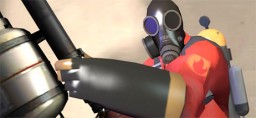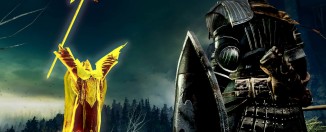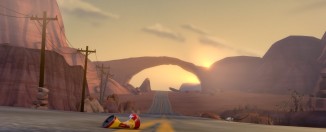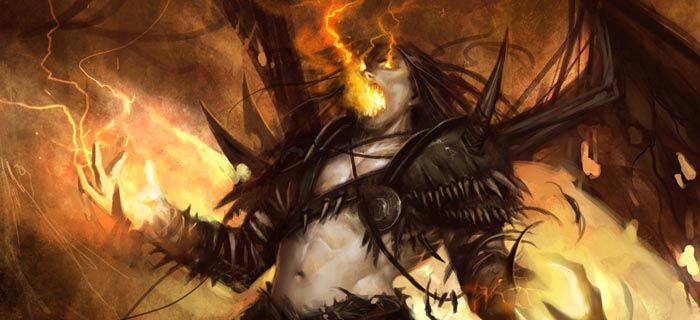How do you solve a problem like the Pyro? (Part 2: Solutions)
 The last time we talked about the perpetual problems perplexing the Pyro, I identified three of his/her/its biggest hurdles:
The last time we talked about the perpetual problems perplexing the Pyro, I identified three of his/her/its biggest hurdles:
- Few tools to facilitate ambushes
- Poor close quarter combat damage
- Low skill ceiling
While the Pyro is certainly playable, it has certainly attracted a stigma of being a “noob” class, primarily due to the “W+M1” tactic that seems commonplace among pub Pyros. (not that the Pyro is played in anything other than pub servers) But none of these problems is without recourse; I believe there exist a variety of solutions to each, from simple to… fun. For each problem, I’ll list possible answers in order of likelihood.
Please note that while some of these suggestions are wholly original, others are certainly inspired by (or simply coincide with) the ideas of other like-minded pyromaniacs.
Ambush Setups
Let’s begin with the Pyro’s highest-level problem, the lack of ambush setups. As was mentioned last time, the Pyro has no way to effectively get into a position to surprise his opponents, other than tip-toeing around and hoping for the best.
Increase base movement speed – The simplest (and easiest to implement) option would be to simply augment the Pyro’s running rate to perhaps that of the Medic (107% of the Pyro’s current speed). This would give the Pyro enough speed to beat most classes to each area, as well as a means for effectively catching Medics (who are, in essence, the bane of the Pyro’s existence). It would also allow the Pyro to more easily escape hit and run operations.
Provide a “boost” mechanism – Since the dawn of time, mankind has well understood the utility of having a boost for getting through tough situations. Many have suggested giving the Pyro some kind of limited boost: having the airblast perform rocket jumps, making the Backburner an “afterburner” for increased run speed, or giving both flamers a passive pushback that can be used while running backwards to hurl the Pyro in the opposite direction. All of these options would give the Pyro a way to reach places faster than opponents, or to reach places opponents can’t.
Implement massive chaos – Instead of making a more agile, mobile Pyro, give our mute little buddy a means to create ambush situations by manipulating his/her surroundings. For example, the Backburner could have an alternate fire Smoke Cloud that unleashes black smoke in a circle around the Pyro (allies can see through the smoke easily). This would allow Backburner Pyros to cultivate confusion and hysteria on unsuspecting foes. It could also be used to facilitate escapes, protect teammates, or create distractions. Another option could be a reverse airblast for the Backburner that sucks enemies towards the Pyro, preventing their escape from critical-damage flames.
Greater Damage Opportunity
Next comes the Pyro’s somewhat lacking close-range damage. Sure, ambushing is great, but if you can’t kill your enemies before they can kill you, the element of surprise isn’t worth much, especially given the Pyro’s incredibly short range.
Increased base damage – The easiest way to increase the Pyro’s damage output would be to simply raise the damage of the Flamethrower and Backburner by another 10%-15%. When the Pyro launches its attack, it needs to do the brunt of its damage before the enemy can retaliate or escape from the short range of these weapons. In order to balance this change, afterburn damage should be reduced slightly. This will increase the reward on the skillful damage (aiming the flamers) and decrease the reward for unskilled damage (afterburn).
Crippling fire – As anyone who’s ever been completely engulfed in flames can tell you, there’s nothing fun about being set on fire. The pain, oxygen deprivation, and smoke don’t exactly make it easy to jog around looking for water. If either of the Pyro’s primary weapons slowed enemies on contact (à la Natascha), anyone caught in the sights of the Pyro would lose the ability to jump out of range, and be forced to fight fire with panic. If the slowdown were limited to direct flames (not afterburn) and were slightly less powerful than that caused by the Heavy’s gun, it shouldn’t be particularly overpowered.
Explosive damage – For every surprise engagement (the killing kind, not the diamond ring kind), the most important moment is the initial strike. At this point, you have a positional and informational advantage over your opponent. As suggested by Lorc on my last article, explosive (or pressurized) damage would give the Pyro a pressure gauge that would begin full, and rapidly deplete as the trigger is held down. This would give the Pyro a large initial damage burst (when the gauge is full) which would then taper off to discourage W+M1 spam. Ambushes would begin with massive, dangerous damage at short range, just as it should be.
More room for skill
Finally, one must answer the question “How can changes to the Pyro increase its dependency on skill instead of on spam or luck?”
Burn over afterburn – As is, afterburn requires almost no skill to apply. A Pyro could, in theory, jump into a group of enemies, spin around once, and light them all on fire. The other, primary means of dealing damage should instead be emphasized, as it takes considerably more skill to keep a moving target constantly in the Pyro’s blazing crosshairs. Any solution to the Pyro should include an incentive to aim over an incentive to spray and pray.
Precision over guessing – Similarly, players should be rewarded for using their weapons precisely, and not for spamming them incessantly. For instance, the changes to the compression airblast upgraded it from “hard to use, low reward” to “easy to use, high reward.” As such, Pyros everywhere can spam airblast nearly constantly with nearly zero risk. One suggestion would be to add a “combo” element to airblasting. Unsuccessful airblasts would have no effect and reload slowly. Airblasts that successfully reflect projectiles would reload instantly. Airblasts reloaded in this manner would provide crits/minicrits. Thus, succcessive airblasts would be rewarded (first with a short timer, then with damage) while spammers would rarely get these bonuses.
More things to do – If Valve made many of these suggested changes, the Pyro would inherently be a more skillful class to play. Backburner users would have to plan ambushes with smoke screens or vaccuum traps. Flamethrower users would be timing their reflect kills and air jumping into ambush positions. All Pyros would be working harder to aim carefully and store up pressure for increased damage. In essence, the skill ceiling problem is solved when the first two problems are solved.
Conclusion
In order for the Pyro to become a competitive class and lose its current stigma, it must receive not just upgrades, but also changes that reward skill and tactics over spam and luck. While a skilled Pyro certainly performs better than an unskilled one, the ratio between them is much more narrow than the same ratio among Soldiers, Scouts, Snipers, Spies… pretty much everyone.
If the Pyro receives meaningful combat options and becomes better at his intended role, he/she will, de facto, be a class of cunning and accuracy. And, of course, fire.







[…] Read my proposed solutions here! […]
Did it ever occur to you, that perhaps Valve just _wanted_ to have a low-skill-required (“Noob”) class for lesser skilled/talented people to get some sense of achievement without first having to put in 20+ hours of training? And if that’s the case, I think it’s good that the Pyro is slow, not very good in cqc and has a low skill ceiling.
You say, the pyro would only be played in pub servers. I actually don’t have any experience with anything else but pub servers, so may I ask: Is the abilty for spy checking, create chaos and be a nice gungho offensive class really completly dispensible in skilled teams? I thought a pyro would be good for any functioning team (although I’m a aware that four of them are not…)
Nice blog, btw!
bla bla